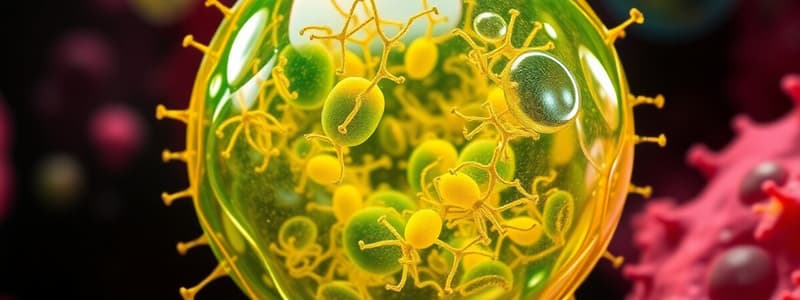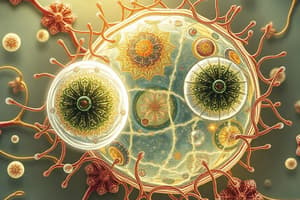Podcast
Questions and Answers
Which of the following is NOT a fundamental tenet of cell theory?
Which of the following is NOT a fundamental tenet of cell theory?
- All cells contain membrane-bound organelles. (correct)
- All living things are composed of one or more cells.
- All cells arise from pre-existing cells through division.
- Cells are the basic units of structure and function in living organisms.
What is the primary distinction between a prokaryotic and eukaryotic cell?
What is the primary distinction between a prokaryotic and eukaryotic cell?
- The presence of a membrane-bound nucleus. (correct)
- The presence of a cell membrane.
- The presence of ribosomes.
- The presence of cytoplasm.
According to the biological species concept, what primarily defines a species?
According to the biological species concept, what primarily defines a species?
- The evolutionary history shared between organisms.
- The physical location where an organism is found.
- The structural features of an organism
- The interbreeding and production of fertile offspring. (correct)
What is the function of pili and flagella in certain prokaryotic cells?
What is the function of pili and flagella in certain prokaryotic cells?
What is the correct way to write the scientific name for humans, using binomial nomenclature?
What is the correct way to write the scientific name for humans, using binomial nomenclature?
According to the provided information, what is the term for a category like 'order' or 'phylum' used in classifying organisms?
According to the provided information, what is the term for a category like 'order' or 'phylum' used in classifying organisms?
Which of the following is true of all cells, regardless of whether they are prokaryotic or eukaryotic?
Which of the following is true of all cells, regardless of whether they are prokaryotic or eukaryotic?
If two organisms are in the same phylum but different orders, which taxonomic level is more inclusive?
If two organisms are in the same phylum but different orders, which taxonomic level is more inclusive?
Which of the following represents the broadest taxonomic grouping in biological classification?
Which of the following represents the broadest taxonomic grouping in biological classification?
What is the primary focus of physiological evidence when determining evolutionary relationships among species?
What is the primary focus of physiological evidence when determining evolutionary relationships among species?
Which of these represents the smallest taxonomic grouping?
Which of these represents the smallest taxonomic grouping?
What is the primary function of DNA evidence in classifying species?
What is the primary function of DNA evidence in classifying species?
If scientists find that two species share a very similar protein structure, what can be inferred?
If scientists find that two species share a very similar protein structure, what can be inferred?
What is the distinction between autotrophs and heterotrophs?
What is the distinction between autotrophs and heterotrophs?
Which of the following is an example of anatomical evidence used in classification?
Which of the following is an example of anatomical evidence used in classification?
How did analyzing the kingdoms Bacteria and Archaea lead to the creation of the domain category?
How did analyzing the kingdoms Bacteria and Archaea lead to the creation of the domain category?
Which characteristic is unique to a retrovirus?
Which characteristic is unique to a retrovirus?
Which of the following best describes the structure of a prion?
Which of the following best describes the structure of a prion?
What is the primary function of methanogens?
What is the primary function of methanogens?
How does a virus differ from a bacterium in terms of cellular structure?
How does a virus differ from a bacterium in terms of cellular structure?
Which characteristic distinguishes halophiles from other archaea?
Which characteristic distinguishes halophiles from other archaea?
Which of the following is the correct order of steps during binary fission?
Which of the following is the correct order of steps during binary fission?
In which form do streptococcus bacteria typically appear?
In which form do streptococcus bacteria typically appear?
What feature of viruses prevents them from dividing by binary fission?
What feature of viruses prevents them from dividing by binary fission?
How do cyanobacteria contribute to the Earth's environment?
How do cyanobacteria contribute to the Earth's environment?
What defines the lysogenic cycle of viral reproduction?
What defines the lysogenic cycle of viral reproduction?
Flashcards
Kingdom
Kingdom
The largest and most inclusive grouping of organisms in the classification system.
Cell Theory
Cell Theory
All living things are made up of one or more cells. Cells are the basic structural and functional units of life. All cells arise from the division of other cells.
Phylum
Phylum
A group of organisms that share common characteristics and a recent common ancestor.
Prokaryotes
Prokaryotes
Signup and view all the flashcards
Class
Class
Signup and view all the flashcards
Eukaryotes
Eukaryotes
Signup and view all the flashcards
Order
Order
Signup and view all the flashcards
Species
Species
Signup and view all the flashcards
Family
Family
Signup and view all the flashcards
Biological Species Concept
Biological Species Concept
Signup and view all the flashcards
Genus
Genus
Signup and view all the flashcards
Taxonomy
Taxonomy
Signup and view all the flashcards
Species
Species
Signup and view all the flashcards
Binomial Nomenclature
Binomial Nomenclature
Signup and view all the flashcards
Ancestor
Ancestor
Signup and view all the flashcards
Taxonomic Categories
Taxonomic Categories
Signup and view all the flashcards
What is a virus?
What is a virus?
Signup and view all the flashcards
What is the lytic cycle?
What is the lytic cycle?
Signup and view all the flashcards
What is the lysogenic cycle?
What is the lysogenic cycle?
Signup and view all the flashcards
What is a prion?
What is a prion?
Signup and view all the flashcards
What is an extremophile?
What is an extremophile?
Signup and view all the flashcards
What is a mesophile?
What is a mesophile?
Signup and view all the flashcards
What are bacteria?
What are bacteria?
Signup and view all the flashcards
What are methanogens?
What are methanogens?
Signup and view all the flashcards
What are halophiles?
What are halophiles?
Signup and view all the flashcards
What are thermophiles?
What are thermophiles?
Signup and view all the flashcards
Study Notes
Cell Theory
- All living things are composed of one or more cells.
- Cells are the fundamental units of structure and function in living organisms.
- All cells arise from pre-existing cells through cell division.
Classifying Cells
- All cells (prokaryotic and eukaryotic) share basic components: DNA, cytoplasm, ribosomes, and a cell membrane.
- Eukaryotic cells contain membrane-bound organelles, specialized structures performing specific tasks within the cell.
- Cytoplasm is largely water, containing organelles and cytosol (the jelly-like substance).
Prokaryotes
- Small, simple, single-celled organisms.
- Lack a membrane-bound nucleus.
- Possess DNA, cytoplasm, ribosomes, and a cell membrane.
- Some employ pili, cilia, or flagella for movement in aquatic environments.
- The number of prokaryotes in a simple sample of soil far exceeds the number of humans who have ever lived.
Eukaryotes
- Large, complex, single-celled or multicellular organisms.
- Possess a membrane-bound nucleus.
- The nucleus houses genetic material (DNA) and functions as the cell's control center.
Species
- A group of organisms capable of interbreeding naturally and producing fertile offspring.
Species Concepts
- Various definitions of species exist.
- Morphological species concept: Focuses on physical characteristics (morphology).
- Biological species concept: Focuses on interbreeding potential.
- Phylogenetic species concept: Emphasis on evolutionary history (phylogeny).
Taxonomy
- The branch of biology concerned with identifying, naming, and classifying species.
- Binomial nomenclature: Standardized two-part naming system (e.g., Homo sapiens).
- First part: Genus; capitalized.
- Second part: Species; lowercase.
- Entire name italicized when typed or underlined when handwritten.
- Carl Linnaeus (or Carl von Linné) is the "father" of taxonomy and binomial nomenclature.
Taxonomic Categories
- Organisms are grouped into hierarchical categories—ranks or taxa.
- Eight ranks are used to classify organisms.
- Examples: Kingdom, Phylum, Class, Order, Family, Genus, Species.
- Example hierarchical organization: King Philip Came Over For Good Soup (Kingdom, Phylum, Class, Order, Family, Genus, Species).
Classification
- Modern classification reflects perceived evolutionary relationships, combining morphological and phylogenetic similarities.
- Evidence types used to establish relationships include anatomical, physiological, and DNA data.
Ancestor
- An organism from which other groups evolved.
Anatomical Evidence
- Structural features (bone structures, internal systems) are compared.
- Evidence of shared structures suggests common ancestors.
- Example: Similar bone structures in the limbs of various mammals (whales, bats, horses, humans).
Physiological Evidence
- Internal processes (e.g., protein functions) are analyzed.
- Comparing proteins' structures provides evidence of relatedness.
- Example: Comparing insulin protein in different species.
DNA Evidence
- DNA sequences are compared among organisms.
- DNA similarities provide evidence of evolutionary relationships.
- Example: DNA evidence revealing that fungi are more closely related to animals than to plants.
Six Kingdoms (and Three Domains)
- Scientists recognized the need for a broader classification system (domains) than kingdoms.
- Bacteria and Archaea are now classified as separate domains.
- Eukarya now encompasses the other four kingdoms.
Autotroph
- Organisms that produce their own food through processes like photosynthesis.
Heterotroph
- Organisms that obtain energy by consuming other organisms.
Virus (Phage)
- Non-cellular infectious agent; requires a host cell for replication.
- Contains DNA or RNA (not both).
- Classified based on various criteria (size, shape, genetic material, host, diseases).
Viral Reproduction
- Lytic cycle: Virus replicates and lyses the host cell.
- Lysogenic cycle: Virus integrates its DNA into the host’s DNA, remaining dormant until activation.
- Retrovirus: Uses reverse transcriptase to convert RNA to DNA.
Prions
- Infectious proteins that cause misfolding of normal proteins (e.g., in the brain).
- Not a virus; lack genetic material.
Bacteria Characteristics
- Prokaryotic, single-celled organisms.
- Often have cell walls.
- Possess circular DNA (plasmids).
- Can be autotrophic or heterotrophic.
- Reproduce asexually via binary fission or sexually by conjugation.
Bacteria Shapes
- Cocci (spherical), bacilli (rod-shaped), spirilla (spiral).
Extremophiles
- Organisms adapted to extreme conditions (e.g., high salt).
Mesophiles
- Organisms adapted to moderate environments.
Archaebacteria
- Methanogens: Methane-producing anaerobes.
- Halophiles: Salt-loving aerobes.
- Thermophiles: Heat-loving organisms.
Eubacteria
- Cyanobacteria: Photosynthetic bacteria, responsible for the Earth’s early oxygen production.
Binary Fission
- Asexual reproduction in bacteria, results in two identical daughter cells.
Studying That Suits You
Use AI to generate personalized quizzes and flashcards to suit your learning preferences.




